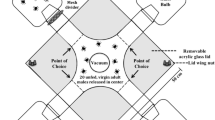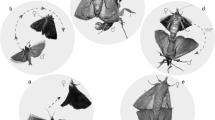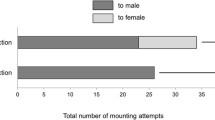Abstract
MaleDermacentor variabilis andD. andersoni respond to an unknown chemical or chemicals present on the body surfaces of partially engorged conspecific female ticks. Following contact, the males mount the females and apply their mouthparts and legs against the female dorsal body surface. Then, the males turn with these appendages still in close contact and crawl to the female's venter, whereupon they locate the gonopore, probe the vulva, and copulate. Similar responses are elicited by heterospecific as well as conspecific females. However, the response is lost when the female cuticle is cleaned (delipidized) with organic solvents. It can be restored by applying hexane extracts prepared from female cuticle to the previously cleaned females. Males do not use surface texture as the primary stimulus for mate recognition. Male ticks also respond to hexane extracts applied to spherical inanimate objects, (“dummy” female), suggesting that a chemical or chemicals soluble in organic solvents has been transferred to these objects. These findings suggest the existence of a previously undescribed pheromone, the mounting sex pheromone (MSP). This contact sex pheromone enables males excited and attracted by 2,6-dichlorophenol to identify the female as a potential mating partner. The MSP is the second in the series of three sex pheromones guiding the hierarchy of behavioral responses which constitute tick courtship behavior.
Similar content being viewed by others
References
Blomquist, G.J., Dillwith, J.W., andPomonis, J.G. 1984. Sex pheromone of the housefly. Metabolism of (Z)-9-tricosene to (Z)-9,10-epoxytricosane and (Z)-14-tricosen-10-one.Insect Biochem. 14:279–284.
Carlson, D.A., Langley, P.A., andHuyton, P. 1978. Sex pheromone of the tsetse fly: Isolation, identification, and synthesis of contact aphrodisiacs.Science 201:750–753.
Cone, W.W. 1979. Pheromones of Tetranychidae, pp. 309–317in J.G. Rodriguez (ed.). Recent Advances in Acarology, vol. 2. Academic Press, New York.
Gilby, A.R. 1980.In T.A. Miller (ed.). Cuticular Techniques in Arthropods. Springer-Verlag. New York.
Khalil, G.M., Sonenshine, D.E., Sallam, O., andHomsher, P.J. 1983. Mating regulation and reproductive isolation in the camel ticks,Hyalomma dromedarii andHyalomma anatolicum excavatum.J. Med. Entomol. 20:136–145.
Oliver, J.H., Jr. 1972. Cytogenetics of ticks (Acari: Ixodoidae). 6. Chromosomes ofDermacentor species in the United States.J. Med. Entomol. 9:177–182.
Sokal, R.R., andRohlf, F.J. 1969. Biometry: The Principles and Practices of Statistics in Biological Research. W.H. Freeman, San Francisco.
Sonenshine, D.E. 1985. Pheromones and other semichemicals of the Acari.Annu. Rev. Entomol. 30:1–28.
Sonenshine, D.E., Silverstein, R.M., Collins, L.A., Saunders, M., Flynt, C., andHomsher, P.J. 1977. Foveal glands, source of sex pheromone production in the ixodid tick,Dermacentor andersoni Stiles.J. Chem. Ecol. 3:695–706.
Sonenshine, D.E., Khalil, G.M., Homsher, P.J., andMason, S.N. 1982.Dermacentor variabilis andDermacentor andersoni: Genital sex pheromones.Exp. Parasitol. 54:317–330.
Watson, P. 1986. Transmission of a female sex pheromone thwarted by males in the spiderLinyphia litigiosa (Linyphiidae).Science 233:219–221.
Author information
Authors and Affiliations
Additional information
Supported by grant AI 10,986 from the National Institute of Allergy and Infectious Diseases, National Institutes of Health, U.S. Public Health Service, Department of Health and Human Services, Bethesda, Maryland 20205.
Rights and permissions
About this article
Cite this article
Gordon, J., Hamilton, C. & Sonenshine, D.E. Evidence for occurrence of mounting sex pheromone on body surface of femaleDermacentor variabilis (Say) AndDermacentor andersoni (Stiles) (Acari: Ixodidae). J Chem Ecol 14, 401–410 (1988). https://doi.org/10.1007/BF01022555
Received:
Accepted:
Issue Date:
DOI: https://doi.org/10.1007/BF01022555




